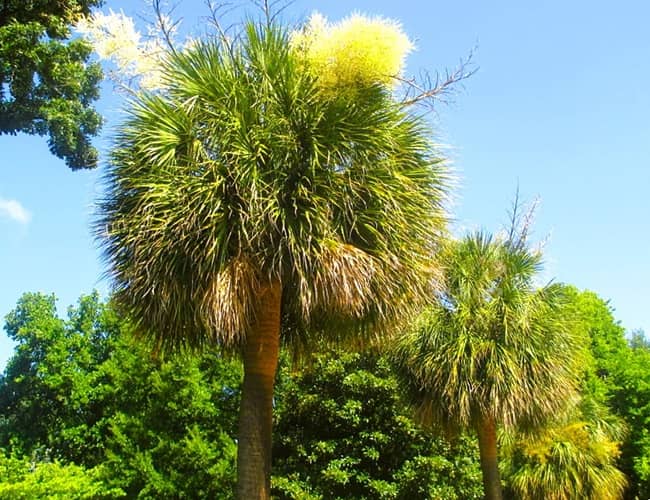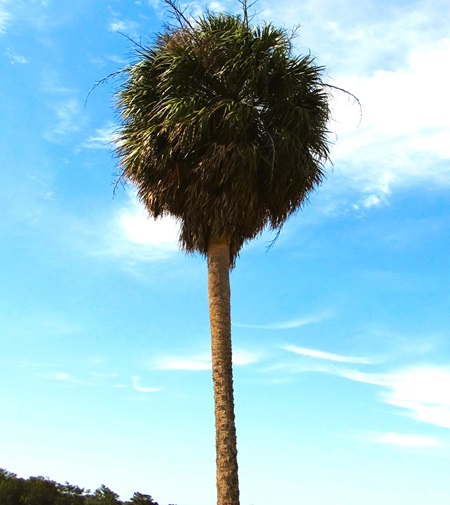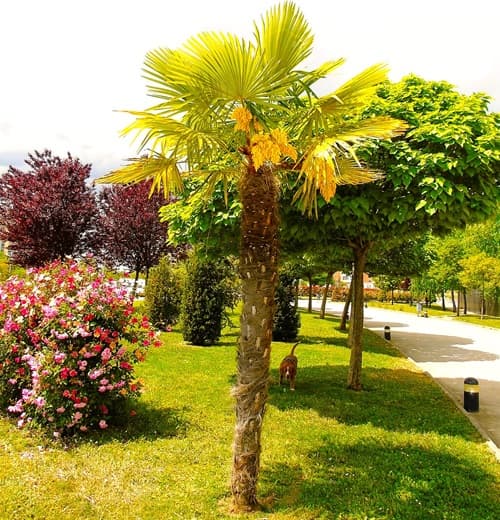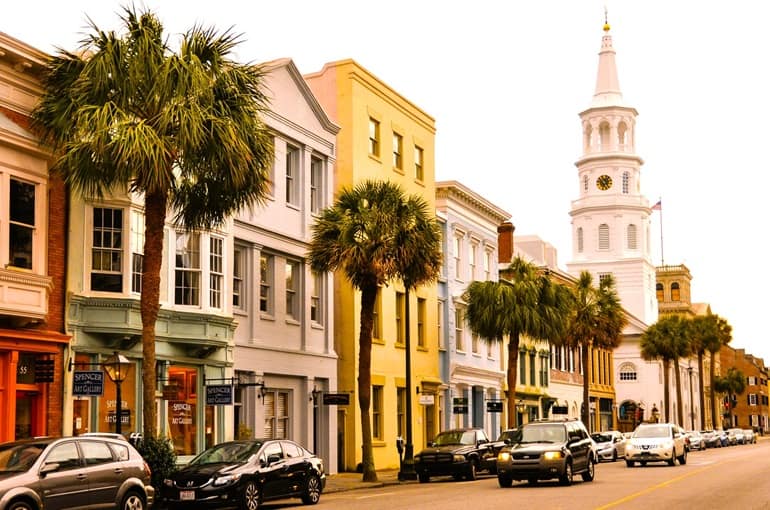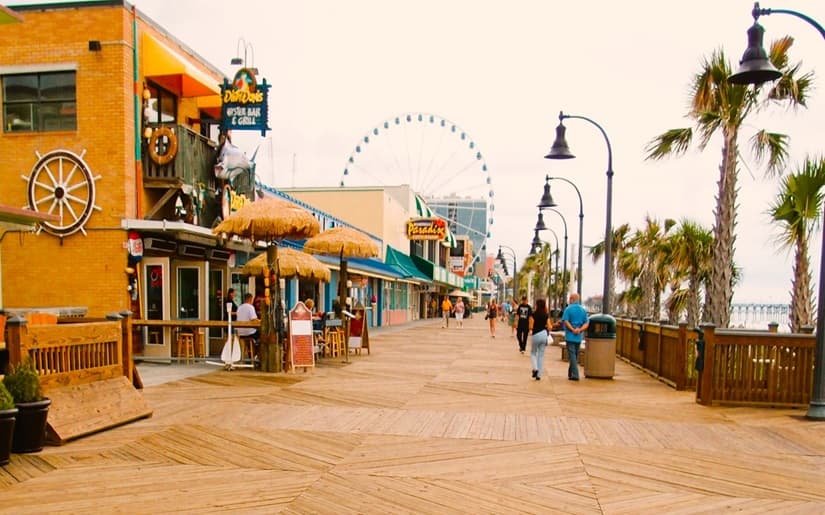- Home
- Palms in U.S.
- South Carolina Palms
Palm Trees in South Carolina
Palm trees in South Carolina give you that tropical feel while roaming through different areas. Promoting this U.S. State as a place for relaxation & fun under the palms.
You may be wondering about South Carolina Palms for several reasons:
- You're planning to enhance your South Carolina landscape.
- You want to understand which palms are suited for South Carolina’s climate, as you want to plant a palm.
- You're just curious about the palm trees you'll be seeing on a South Carolina Vacation.
In South Carolina’s natural environment, understanding how these palms fit the local ecosystem is helpful.
At Mission: Palm Trees
Palm lovers can soothe their palm-related searches and concerns. Our articles are intended to inform, while having fun, easily Finding What You Want or Need. Without unneeded shoptalk & tiring endless research. We Research For You!
What is the State Tree of South Carolina?
Did you ever hear that the state tree of South Carolina is a palm? Yes, Sabal palmetto has been given this honor. You'll see it on the state flag, to exemplify the spirit of South Carolina.
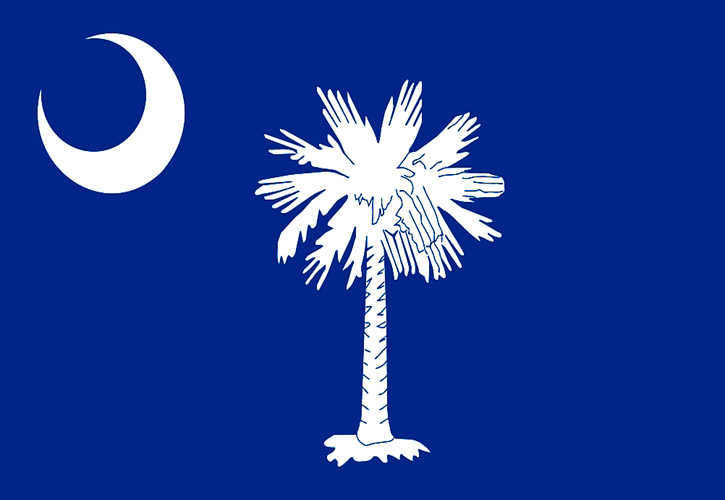 Images that are part of the South Carolina state glag
Images that are part of the South Carolina state glag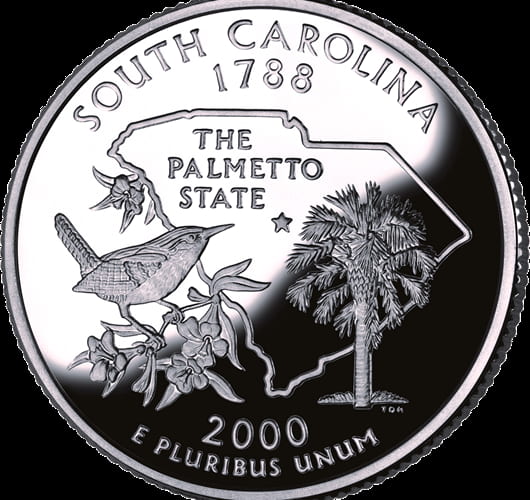 Proof of the South Carolina Quarter
Proof of the South Carolina QuarterCommonly called the Cabbage Palm, Palmetto Tree or Cabbage Palmetto.
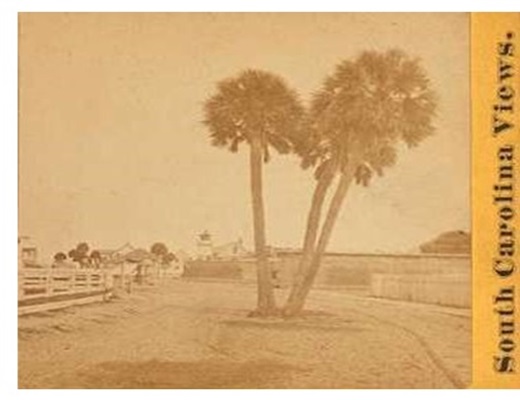 Vintage Pic of South Carolina Sabal palmetto Palms
Vintage Pic of South Carolina Sabal palmetto PalmsTaken Near Fort Moultrie on Sullivans Island
Why is Sabal Palmetto Suited to South Carolina?
The Sabal palmetto is native to the southeastern US. Of course that includes South Carolina. But it's also one Palm Growing in North Carolina along southern coastal areas. Its environment also includes most of Florida (including the Keys) & Cuba. And the Bahamas, too.
Why does the Cabbage Palm love growing in South Carolina?
This Palm Tree Species loves warmer coastal areas, which includes the SC coast. But it also loves a wide variety of South Carolina settings. Like swamps, along streams & pine scrub forests.
But sometimes an excessively cold front comes through. This palm withstands some frigid temps. One of the most Cold-Hardy Palms, it grows fine in SC Growing Zones 8-11. And even in 7b, with care.
When established...
- It gets by in salty areas, but shows its survival stress.
- It tolerates a temporary drought, once established.
It grows slowly while forming its initial trunk. Then speeds up a bit, & can reach 90ft/27m high with ideal conditions.
What's special about the Sabal palmetto?
Its beautiful fully round crown gives a striking focus to any landscape. It's almost reminiscent of a giant lollypop with an extra long stick! 😉 Please Don't Prune those living green fronds away!
Identification can be difficult, when deciding among Sabal species.
- When found in nature, there's a relatively smooth, light gray or light tan trunk.
- In landscaping, some manipulate fronds When Pruning. Leaving petiole (the leaf stem) bases (boots) for decorative purposes.
- Look for its palmate (fan-shaped) deeply green leaves. And Fronds Having Costapalmate styling (see pic below).
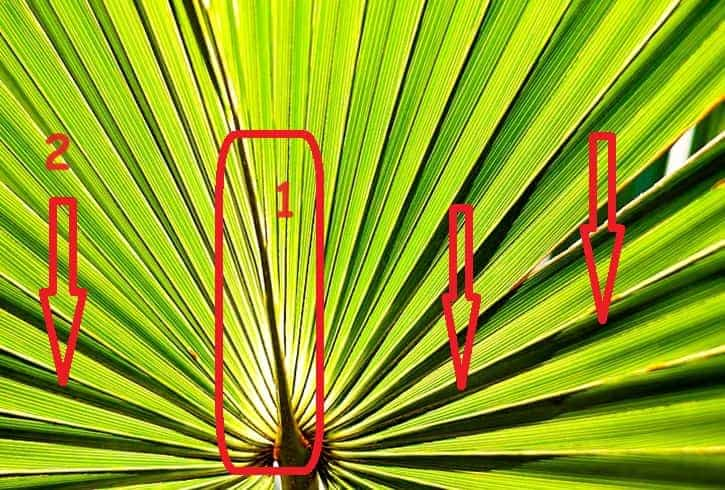 S.palmetto Frond Close-Up:
S.palmetto Frond Close-Up:1) Where the Petiole enters the blade, a hastula (initial bump) is on the upper surface. Then the costa petiole (stem) curves way into the blade.
2) Each segment deeply into the blade leaving gaps.
Other Palm Trees in South Carolina
Yes there are other palm trees in South Carolina gracing landscapes.
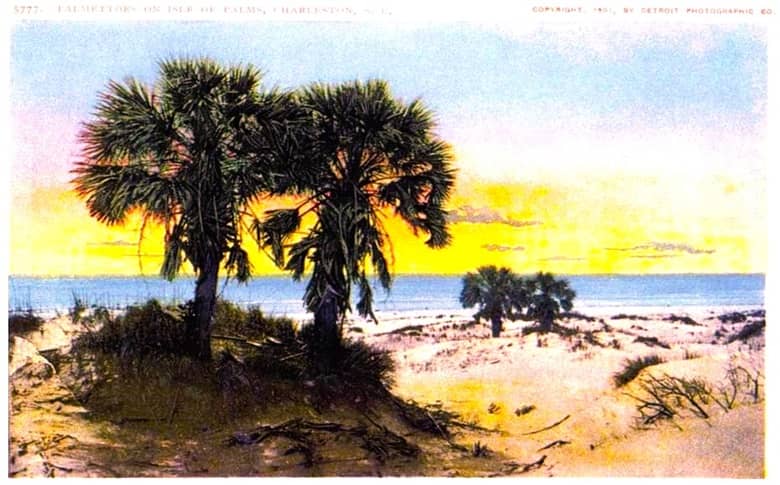 Sabal palms on the Dunes of Isle of Palms at Sunrise - Vintage 1951 Postcard
Sabal palms on the Dunes of Isle of Palms at Sunrise - Vintage 1951 PostcardGrowing a Pindo Palm in South Carolina
Butia capitata is known for cold hardiness, making it a cool choice (No Pun Intended!) for South Carolina gardens.
Also nicknamed Jelly Palm because of its delish edible orange fruits. Some people do make jelly out of them.
In South Carolina's typical climate, it does best in Zones 9-11. If you live in a dryer Mediterranean-like SC environment, Zone 8 can do it!
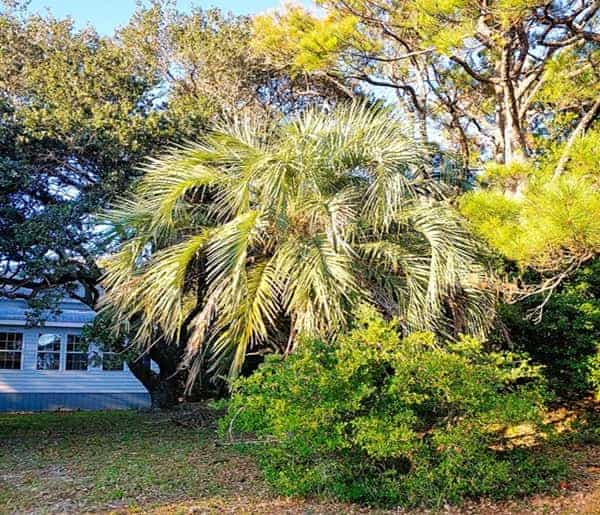 Healthy Jelly Palm in a backyard landscape.
Healthy Jelly Palm in a backyard landscape.Photo: Cool Guy Slate - CC BY-SA 4.0
Windmill Palms Ideal for South Carolina Climates
Trachycarpus fortunei is one of the best palms for South Carolina. Because it has notable cold hardiness, suitable for Zones 7b-11. Ideal because that covers all the state's zones!
Called the Windmill Palm because its fan-shaped pinnate frond segments are fairly stiff. Looking to catch wind in its canopy of 20-30 leaves!
Its trunk catches your attention. With its brown hairy matting that becomes gray with age. Leaf bases peek out.
Don't Miss the Needle Palm for South Carolina
Rhapidophyllum hystrix is probably the hardiest palm in the world.
It's ideally suited for Zones 8-10b. As a clustering palm, it's shrubby form maxes out at 5-12ft/1.5-4m tall. Commonly found along coastal South Carolina.
Makes a fabulous protective hedge. With its growing point (meristem) topped with long needle-like bristles. Surrounded by deeply green fan palms.
It does well in shady sites, as it natively grows as an understory palm.
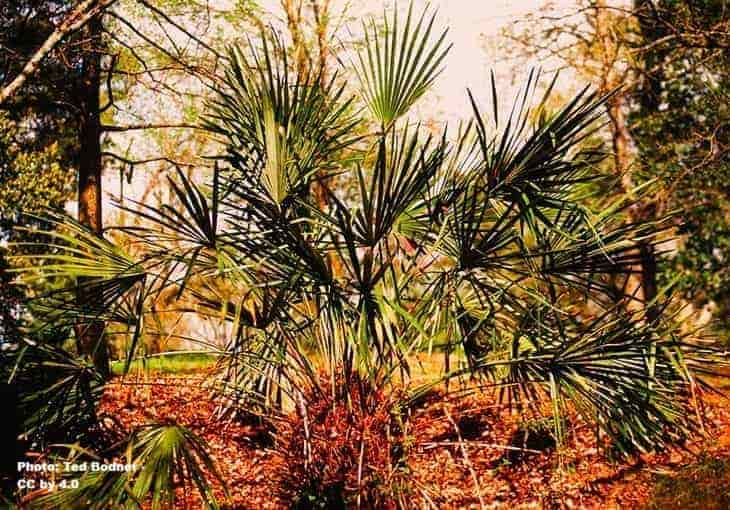 Rhapidophyllum hystrix has been known to survive temps down to -10 Degrees F (-23C).
Rhapidophyllum hystrix has been known to survive temps down to -10 Degrees F (-23C).Photo: USDA Ted Bodner. Southern Weed Science Society US - CC BY 4.0
South Carolina Palm Tree Landscaping & Care
Plan Your South Carolina Landscaping With Palms
Your success in landscaping with palm trees in South Carolina involves some basic care.
- Imagine lining driveways or walkways with stately Palmettos
- You could create a secluded garden nook with bushy Needle Palms.
- How about using a Sabal or Windmill Palm as a focal point in your front yard.
Each species has a unique texture & form. Use Planning for Creative Landscape Designs to reflect your personal tastes. Which may also enhance property values.
Know the Basic Palm Care for SC
It's not overly complicated to care for these palms of South Carolina. Here are some general tips when Caring for Palm Trees that could help you if you're planning on one.
- Nearly all palms prefer well-draining soil.
- Plant your palm where it will get full to partial sunlight. Depending on the species.
- Regular watering during the first year helps establish palm trees in South Carolina. Enabling a strong root system. Once mature, many palms are fairly drought tolerant.
The essential point for growing palm trees in South Carolina is to get the right palm in the right USDA Hardiness Zone. That will make for easiest success.
Traveling to Palmy Places in South Carolina
Are you planning a trip to South Carolina. Or maybe you'll be moving there?
These palm trees in South Carolina are a wonderful part of the local flora. When visiting, you'll experience the tropic-like aesthetic of palms.
We have samples of places to go to surround yourself with South Carolina's palms:
- Visit Columbia to experience the State's Capitol. Or enjoy the Riverbanks Zoo & Garden.
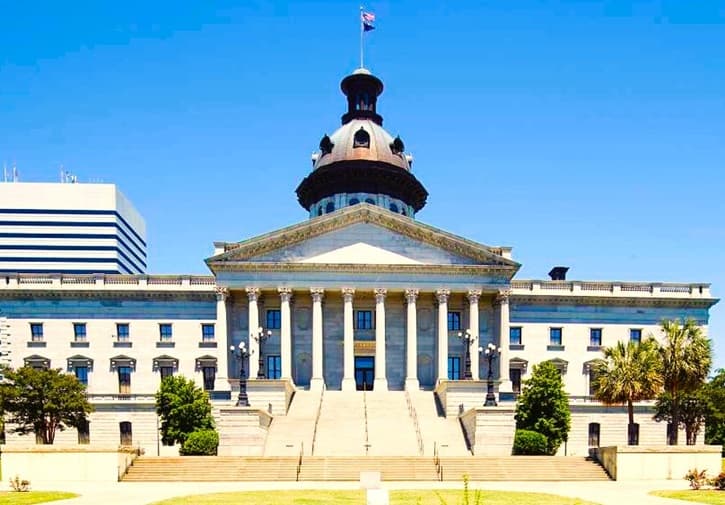 Two Palms Alongside the South Carolina State House in Columbia
Two Palms Alongside the South Carolina State House in Columbia- Stroll through Charleston’s historic district.
- Visit coastal areas like Myrtle Beach.
You'll become familiar with the palm trees in South Carolina as you embrace scenic views. All stunning places to see which contribute to the state’s charm & character.
Takeaways for Palm Trees in South Carolina
Are you a homeowner looking for some tropic-like aesthetic to your yard? Are you looking to visit this rich biodiversity in South Carolina. Either way, palms offer their beauty for you.
From the stately Sabal palmetto to the rugged Needle Palm, they're not just plants but symbols of resilience and beauty.
Therefor palm trees in South Carolina are more than only landscaping options. They're a vital part of the state's identity and natural heritage. South Carolina palms are a treasure worth exploring. Why not start your palm adventure planning today?
